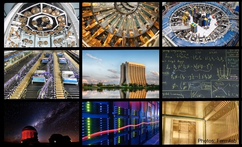Speaker
Description
The Mu2e experiment will search for a Standard Model violating rate of neutrinoless conversion of a muon into an electron in the presence of an aluminum nucleus. Observation of this charged-lepton flavor-violating process would be an unambiguous sign of New Physics. Mu2e aims to improve upon previous searches by four orders of magnitude. This requires the world's highest-intensity muon beam, a detector system capable of efficiently reconstructing the 105 MeV/c conversion electrons, and minimizing sensitivity to background events. A pulsed 8 GeV proton beam strikes a target, producing pions that decay into muons. The muon beam is guided from the production target along the transport system and onto the aluminum stopping target. Conversion electrons leave the stopping target and propagate through a solenoidal magnetic field and are detected by the tracker and electromagnetic calorimeter. Here, I will introduce and outline the physics, goals, and expected performance of the Mu2e experiment, which is currently on schedule to report its search for New Physics this decade.
